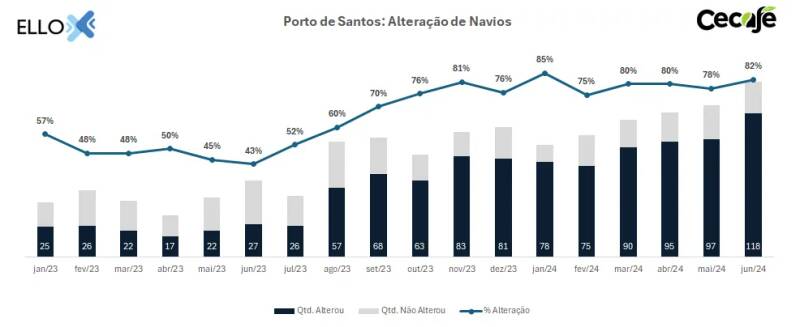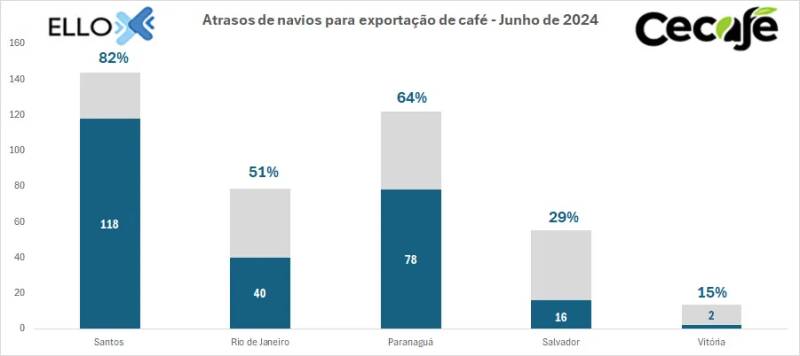Delays at Brazilian terminals are serious! Damage reached US$290 million
According to the coffee port export report released by Cecaf on July 19, a total of 413 container ships were responsible for coffee export in June, but 254 of them encountered delays or changes in the middle of the voyage at major ports, accounting for 62%.

In addition, the Brazilian Coffee exporters Committee Cecafe surveyed 30 export companies and noted that in June alone, due to ship delays, changes in deadlines, lack of space at ports and lack of manpower, Brazil halted the export of 1.23 million bags of coffee (60 kg / bag).
The export of these 1.23 million bags of coffee stopped, reducing foreign exchange earnings by 1.588 billion reais (about US $290 million) a month. And caused losses of about 4.7 million reais to these 30 companies. In terms of ports, the delay rate of Santos, Brazil's largest port, reached a new high of 82%, while the delay rate of Rio de Janeiro and Itaguai reached 51% in June.

Victoria Harbour is another port that suffers from serious logistics bottlenecks due to queuing of ships, scarcity of containers, difficulties in gate control, shortage of cargo handling space and manpower, this leads to the loss of goods, the transfer of goods to other ports and the increase in the cost of coffee transportation. According to statistics, Victoria Harbour stopped 374000 bags of coffee in June, equivalent to 30% of Brazil's unshipped coffee last month, reducing Brazil's foreign exchange earnings by about 480 million reais (about US $89.5 million).
In addition to the serious export problems, weather problems also affect the Brazilian coffee industry. According to a report released by the Brazilian breath Bureau on July 19, the high temperature in parts of central, western and northeastern Brazil is even stronger, and the maximum temperature will be very high. In the coming period of time, a large amount of dry and hot air will bring strong high temperature weather to most parts of Brazil, mainly affecting the southeast, north and northeast of the central and western part of the country, with high temperatures of more than 35 ℃ in many cities.
It is said that the northeastern states of Brazil are currently expected to experience the worst high temperatures, with maximum temperatures of around 35 °C or even higher than 35 °C in many cities, with records as high as 37 °C or 38 °C. And in the next few days, the dry and hot air mass will gradually strengthen, the high temperature area in Brazil will continue to expand, the maximum temperature will continue to rise, and the high temperature will last longer.
At this time of year, drier areas such as Minas Gerais and the interior of S ã o Paulo will experience the hottest weather. However, the situation is similar in southern Brazil, where afternoon temperatures are expected to be higher than the historical average in July, but at high altitudes in the south, the night will become colder or even frost.
It is understood that the high temperature will be concentrated in central and northern Brazil, and there are many coffee producing areas, such as Miraguillas, Sao Paulo and Esp í rito Santo, and so on. The high temperature will have a lot of impact on these coffee producing areas.
At present, it is in the harvest season of Brazilian coffee, although the current dry weather conditions are conducive to harvest, but at the same time have a lot of impact on the yield. In Milashiras, drought and high temperatures have a great impact, which may scorch coffee leaves. In addition, high temperatures will also be conducive to the reproduction and spread of diseases and insect pests, and there has been less rainfall recently, resulting in a decline in coffee production and quality.
Brazil has so far harvested 66 per cent of this year's total coffee production, according to Safras, a local consultancy. However, due to the dry weather, coffee production is lower than market expectations, and coffee beans are too small. Coupled with the coming hot weather, production will decline further, and the latest market is expected to reduce production by 2 to 3 million bags (60 kg / bag), which may keep coffee prices high.
In addition, according to data released by the Brazilian Ministry of Health on July 18, the number of suspected and confirmed cases of dengue fever in Brazil has risen to 6365727 since 2024, the number of deaths has risen to 4691, and there are another 2381 deaths to be verified. At present, Brazil has the highest number of confirmed and suspected cases of dengue fever in the world, and the current hot weather has also aggravated the disease.
At present, the condition of dengue fever affects Brazil's human resources problems, indirectly affecting Brazilian coffee exports. To this end, the president of the Brazilian Coffee exporters Committee said that although Santos Port has maintained a leading position in the transportation of overseas products, the delay rate has been rising since 2022 and remains at 80% today. The government hopes that the government can solve the problem of port delays as soon as possible.
Important Notice :
前街咖啡 FrontStreet Coffee has moved to new addredd:
FrontStreet Coffee Address: 315,Donghua East Road,GuangZhou
Tel:020 38364473
- Prev

Logo War! There are not many symbols left for the coffee shop
▲ Click to pay attention| Daily Boutique Coffee Culture Magazine Coffee Workshop Recently, a netizen wanted to order a drink. When he opened the takeout app, he searched the coffee shop. The interface popped up with a black symbol on a white background. He couldn't help but sigh,"Nowadays, coffee roll calls are so abstract?" This discovery made netizens suddenly open their minds
- Next

Is there a big difference in concentration extracted by a few tenths of a gram of powder? Why do I have to use an electronic scale to make coffee?
Friends who visited the store saw the process of making concentration on Qianjie. Whether it is grinding or extracting coffee liquor, an electronic scale will be used for measurement. So he asked: It's just making coffee. Why should it be so precise? More powder and less powder, more liquid and less liquid, more time and less time, the flavor of espresso coffee
Related
- What effect does Italian American coffee with filter paper have? Will coffee taste better if it is put on filter paper at the bottom of the powder bowl?
- What is the color difference in coffee beans? What are the characteristics of honey processed coffee beans? Why are the anaerobically treated coffee beans uneven in color?
- How does novice Xiaobai quickly get started and make coffee? Newbies learn to make coffee by hand and share the specific steps and process process!
- Costa tea has a shelf life of 100 years?! Expert: Unable to verify
- It's a huge uproar! American milk addition was rejected by Manner employees?!
- Mocha pot coffee bean recommendations| How fine and how much powder should be used for grinding? What parameter ratios do I need to use to make milk with Mocha pot coffee?
- What are the characteristics of the world's top ten coffee beans treated with Costa Rica honey? How to make black honey kadura from Tarazhu Pilon Processing Plant taste good?
- How to make deep-roasted coffee? What grinding water temperature does authentic Jamaica Blue Mountain No. 1 coffee use to brew it well?
- Selected high-grade rose summer coffee flavor tasting guide Why Panama rose summer has the aroma of flowers and fruits
- What equipment does a novice Xiaobai need to buy to learn to make coffee? Filter cup electronic scale bean grinder manual flushing pot purchase guide

